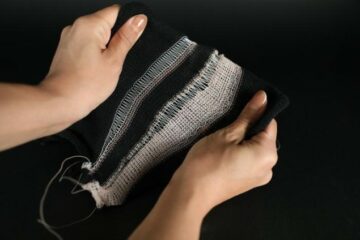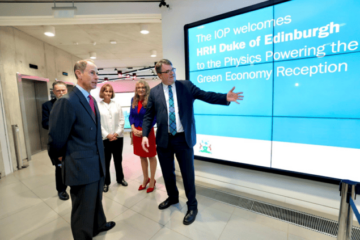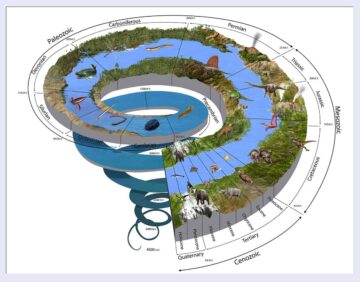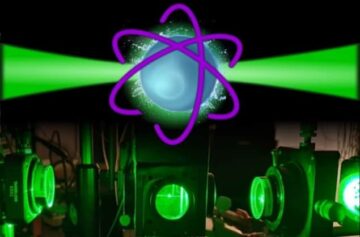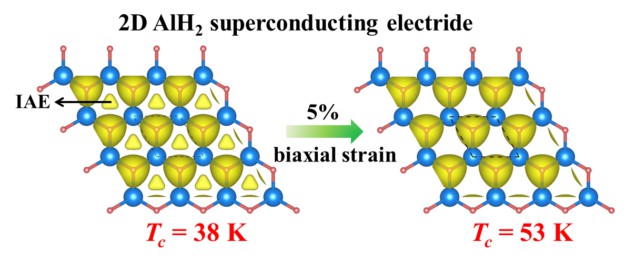
A new theoretical study sheds fresh light on the relationship between superconductivity and “excess” electrons in materials known as electrides. The study, on a monolayer of aluminium hydride, shows that this material should be a conventional superconductor with a critical transition temperature TC of 38 K – the highest known transition superconducting temperature among all two-dimensional electrides reported to date.
Electrides are a type of exotic ionic solid that contain more electrons than expected from classical (valence bond) theory. These additional electrons are known as interstitial anionic electrons (IAEs) because they are not bound to any atoms. Instead, they are trapped in voids within the material’s crystalline lattice.
Theory suggests that manipulating these IAEs could offer a new route to modulating a material’s electronic properties. Another, even more tantalizing possibility is that IAEs could interact more strongly with vibrations of the crystal lattice (phonons) than “normal” electrons do, which would lead to superconductivity.
Most superconducting electrides studied to date, however, have been bulk three-dimensional materials, which become superconducting only at very high pressures (hundreds of gigapascals) or very low temperatures (below 10 K). This limits their applications in areas such as superconducting quantum interference and single-electron superconductor quantum dot devices.
More promisingly, researchers recently discovered that two-dimensional (2D) electrides can also behave as superconductors – and at normal pressures, too. Unfortunately, the 2D electrides studied previously still suffer from very low Tcs.
A new monolayer material
In the latest work, Jijun Zhao and colleagues at the Key Laboratory of Materials Modification by Laser, Ion and Electron Beams at the Dalian University of Technology, China studied a monolayer of aluminium hydride (AlH2) in which excess anionic electrons provided by the aluminium are confined in the interstices of the aluminium lattice. This 2D material is stable thanks to the interactions between the IAEs and the lattice.
Using electron localization function analyses, the researchers found that the aluminium-hydrogen bond is ionic and that each hydrogen atom gains around 0.9 electrons from each aluminium atom, which tends to lose three valence electrons. However, since the H– anion cannot accommodate any more electrons, any remaining electrons provided by the aluminium end up in the interstices of the lattice, resulting in a zero-dimensional electride state. Further calculations confirmed the presence of the IAEs and this electride state.
Highest Tc for any known 2D electride
Unexpectedly, the Dalian team also found that the IAEs provided by the aluminium are not responsible for the material’s superconductivity. This, says Zhao, is “another innovative point in our work” and “in contrast to what has been observed for most previously known superconducting electrides”. Instead, it is the hydrogen atoms’ 1s electrons that strongly couple with the phononic vibrations of aluminium that allow the material to become a conventional (“BCS”) superconductor with a Tc of 38 K.

Palladium oxides could make better superconductors
And that was not all: the researchers also found that applying a biaxial strain of 5% to the AlH2 can increase this Tc to 53 K. This is because the strain converts the IAEs into itinerant electrons, which promotes the formation of the stable Cooper electron pairs required for superconductivity, they say.
“Our theoretical study establishes a unified picture about the relationship between IAEs, the dynamic stability of the host lattice and superconductivity in the AlH2 monolayer,” team member Xue Jiang tells Physics World. “It presents a significant step toward the comprehensive understanding of 2D superconducting electrides, which in turn, open new avenues towards novel classes of high-Tc low-dimensional superconductors.”
The Dalian University of Technology team is now focusing on a wider range of low-dimensional materials with superconductivity or other exotic electronic properties.
The work is detailed in Chinese Physics Letters.
- SEO Powered Content & PR Distribution. Get Amplified Today.
- PlatoData.Network Vertical Generative Ai. Empower Yourself. Access Here.
- PlatoAiStream. Web3 Intelligence. Knowledge Amplified. Access Here.
- PlatoESG. Carbon, CleanTech, Energy, Environment, Solar, Waste Management. Access Here.
- PlatoHealth. Biotech and Clinical Trials Intelligence. Access Here.
- Source: https://physicsworld.com/a/two-dimensional-electride-material-makes-a-promising-superconductor/
- :has
- :is
- :not
- $UP
- 10
- 160
- 2D
- 80
- 9
- a
- About
- accommodate
- Additional
- All
- allow
- also
- among
- analyses
- and
- Another
- any
- applications
- Applying
- ARE
- areas
- around
- AS
- At
- atom
- avenues
- BE
- because
- become
- been
- behave
- below
- Better
- between
- bond
- bound
- by
- calculations
- CAN
- cannot
- Changes
- China
- classes
- colleagues
- comprehensive
- Configuration
- CONFIRMED
- contain
- contrast
- conventional
- cooper
- could
- Couple
- critical
- Crystal
- Date
- detailed
- Devices
- discovered
- do
- DOT
- dynamic
- each
- Electronic
- electrons
- end
- establishes
- Even
- excess
- Exotic
- expected
- focusing
- For
- formation
- found
- fresh
- from
- function
- further
- Gains
- Have
- High
- highest
- Hit
- host
- However
- http
- HTTPS
- Hundreds
- hydrogen
- image
- in
- Increase
- information
- innovative
- instead
- interact
- interactions
- interference
- into
- Ionic
- issue
- IT
- jpg
- known
- laboratory
- laser
- latest
- lead
- light
- limits
- Localization
- lose
- Low
- make
- MAKES
- manipulating
- material
- materials
- max-width
- member
- might
- more
- most
- New
- normal
- novel
- now
- observed
- of
- offer
- on
- only
- open
- or
- Other
- our
- pairs
- Physics
- Physics World
- picture
- plato
- Plato Data Intelligence
- PlatoData
- Point
- possibility
- presence
- presents
- pressures
- previously
- promising
- promotes
- properties
- provided
- Quantum
- Quantum dot
- raises
- range
- recently
- relationship
- remaining
- Reported
- required
- researchers
- responsible
- resulting
- Route
- say
- says
- should
- Shows
- significant
- since
- solid
- Spot
- Stability
- stable
- State
- Step
- Still
- strongly
- studied
- Study
- such
- suggest
- Suggests
- Superconductivity
- sweet
- tantalizing
- team
- Technology
- tells
- tends
- than
- thanks
- that
- The
- their
- theoretical
- theory
- These
- they
- this
- three
- three-dimensional
- thumbnail
- to
- too
- toward
- towards
- transition
- true
- TURN
- type
- understanding
- unfortunately
- unified
- university
- very
- was
- What
- which
- wider
- with
- within
- Work
- world
- would
- zephyrnet
- Zhao




